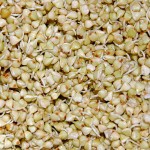We have talked already about the way to dissect your boxed breakfast cereal, but what if you could get an even more nutritious version that would taste even better?
Welcome to the world of sprouted buckwheat!

 Benefits of Buckwheat
Benefits of Buckwheat
- Gluten free
- Complete protein (all essential amino acids)
- High in Rutin – a compound that is known to be a powerful capillary wall strenghener. Good for varicose veins, hardening of the arteries
- High in Lecithin – Lowers Cholesterol, Brain Booster
- High in Iron, Calcium and Boron
- High in bioflavonoids, coQ10
So, why sprout instead of eating the toasted version Kasha?
Sprouting actually takes a nut or seed that is in a dormant state and brings it to life. In anyone has every sprouted, you can actually see before your eyes this seed that was once sitting on the shelf for months actually begin to grow and reclaim life. When this happens, the nutrients and enzymes also come to life. This means the food is much easier to digest, contains live enzymes, and more absorbable nutrition. Basically, it is supercharging your food!
Sounds great, how much time is it going to take?
The great answer to this is no time at all. While in total it takes about 2 days to complete this process, your actually hands on time is a matter of minutes.
How do I begin to make Sprouted Buckwheat – Yields 1 Cup
- Go to your local health food store and purchase buckwheat (non toasted, roasted). They will sometimes be labeled groats.
- Mix 2/3 of a cup of buckwheat with 2-3x more water
- Stir the buckwheat so there are no seeds sitting on top
- Soak the seeds for about 1 hour
- Empty your seeds into a strainer. So, don’t make the mistake I made of putting the buckwheat in a strainer with big holes. Make sure the strainer holes are small enough that the buckwheat wont leak through and rinse with cold water
- Empty your seeds into a sprouter. If you don’t have a sprouter, you can get one they are everywhere (health food store, chapters, homesence). Or, you can actually sprout on cookie sheets – so spread the buckwheat evenly on top of a cookie sheet
- There is a goopy substance (the starch) that you will notice collects on the buckwheat. For this reason, you will need to put the buckwheat back into the strainer and rinse 3 times a day. This is where the sprouter comes in handy as you don’t need to keep transferring between the cookie sheet and strainer.
Eventually you may want to get a sprouter, however – to start…don’t let this stop you…just try it the old fashioned way.
- 2 days later – your buckwheat will start growing tails. You are done!
- Now – you can stop here. OR, you can dehydrate the buckwheat to make it crunchier but still keep all of the live benefits. Again, the best option is to have a dehydrator – but again don’t let that stop you as you can use your convection oven. Set the oven as low as it can go, mine is 150F.
Enzymes are destroyed at temperatures above 110F, so we need to leave the oven open a bit to let some heat out. I usually take a steel serving spoon and lodge it in the oven. Bake the sprouted buckwheat on a cookie sheet for 5-6 hours.
DONE!! Now place this in a sealed glass jar and enjoy
Please try these recipes, or share any that you have on our website.
Recipes
Classic Cereal
- ¼- ½ cup buckwheat
- ¼ cup seeds/ nuts of your choice
- 2 tbsp of gogi berries or raisins
- ¼- ½ cup fresh berries
- Almond milk
Sprouted Buckwheat Chocolate Banana Sundae
- 1 Banana
- 1 cup Sprouted Buckwheat (this doesn’t need to be dehydrated)
- 1 Teaspoon Raw Chocolate Powder
- 1 Teaspoon Agave Nectar
- Splash of Warm Water
**this is basically a protein shake, where you are using the buckwheat as your protein powder
